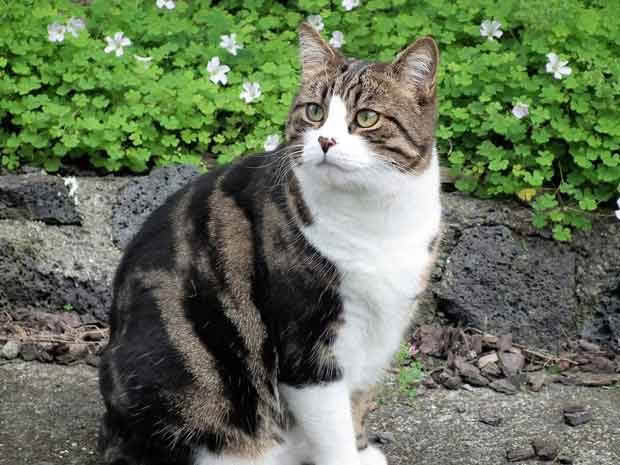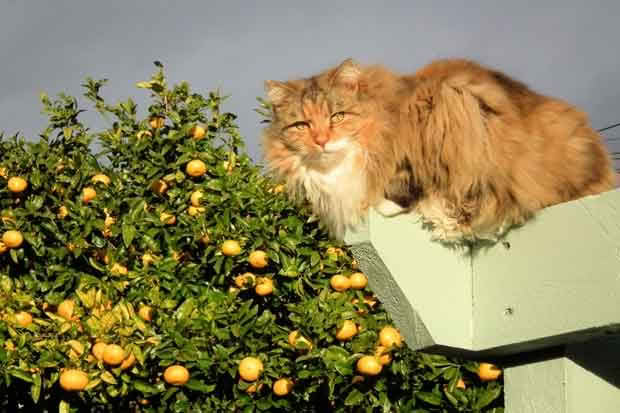How to garden with cats

Barney the cat.
Kirsty Pascoe is an avid gardener who has applied permaculture principles to her back yard and her cats.
Cats have been kept by mankind for centuries, some for pure companionship, some revered for their specific breed traits, some for their hunting abilities.
Farmers more than anyone know how useful a cat can be in keeping mice and rodent numbers down and for protecting their stock feed. But in the suburban setting, at least where I live in New Zealand, cats seem to have become unfairly targeted as a gardener’s number one enemy. If I do a quick search though my local online gardening pages, it takes only a matter of minutes to see many complaints.
“How do I keep my cats out of my garden?”
As a permaculture practitioner, I scratch my head and wonder why on earth you would want to.

Molly on the pergola.
It seems people want to segregate cats from their gardens when they can easily and successfully integrated, becoming a valuable component of the systems we create and use to support our garden’s production.
I’ve searched through many permaculture and lifestyle books and online resources for reference to integrating our furry felines into permaculture designs. There is a plethora of information about chickens, ducks, geese, bees, worms, goats, but when it comes to the benefits of the humble cat, there’s not a mention.
I’m a townie, living on a 500m² residential property in suburban New Zealand. I take many ideas used on lifestyle blocks and try to downsize them to implement on my small property which my neighbours now affectionately refer to as their ‘farm next door’.
I was inspired to create my ‘farm’ while completing my Permaculture Design Certificate. I’ve replaced my entire lawn with a small scale, edible food forest. I don’t waste petrol on lawn mowing. Now I graze my way through 50+ varieties of fruit trees, organic vegetables and edible flowers, alll of which I share with free range chickens and hives of foraging bees.
I am also blessed to share this space with two feline Gods, and it was created with their needs in mind, right from the start of the design phase.
Yes, Molly and Barney are spoilt. Sure, they share my bed and keep me warm on a winter’s night. But they’re also integrated by design because they have jobs to do which help make the food forest successful and productive.
Cats are obligate carnivores. Their bodies are magnificently designed and their instincts sharply honed to find and hunt prey. On my property that prey comes in the form of mice and the occasional rat from a nearby stream, which attempt to burrow into the chook house to dine on grains.

Kirsty’s garden.
I say ‘attempt’ because the cats rapidly intervene, efficiently despatching and then also devouring, which I’m also grateful for. That’s nourishing food for both their bodies and minds, and it saves me an icky clean-up job too. Thanks cats!
Cats are great defenders of ‘their patch’. Mine have accepted the chickens belong here and are now avid guardians, many a time chasing off stray cats that have entertained the idea of chicken tonight.
One of my cats (also the smallest) has developed the persona of a tiger. Molly has chased off dogs and possums. There is the very occasional vet bill when she bites off more than she can chew, but there is no stopping a cat that feels it’s important to defend her territory.
A common complaint is that cats kill wild birds. There’s no denying that. But there are also common complaints of wild birds decimating crops and damaging yields too. In this respect my cats have become my allies. My property is boarded by magnificent, tall, ancient trees where tui and kereru live. I’m quite happy to share the yield which they take from the high canopy layers I can’t reach.
This leaves the cats patrolling the lower reaches, scaring off common sparrows and others, leaving me with more than enough harvest to share with family, neighbours and friends.
The birds in their own way benefit from the cats as well. They seem to recognise when the cats are getting their regular brushing and grooming done outside, quickly flying off with beaks laden with cat hair, presumably to weave into their nests. Not even cat hair gets wasted around here.
One of the perils of suburban living is having the occasional unwanted visitor on site helping themselves to your gardening efforts. While I’m all for sharing, I’m not comfortable having intruders sneaking around my patch at night. My cats and their acute hearing act as my early warning alarm in this respect, warning me of visitors and letting me know all is not right outside. The fences aren’t good enough to contain dogs and I’m ever grateful for my cats’ defence of house and home.
A final common complaint I hear against cats is they dig and poo in the vegetable garden. “How do I stop them!!” people cry. Cats are just like every other living creature and need to poo. My question is, have you given them somewhere they are allowed to go toilet? This usually results in complete silence or a look that says they think I’ve gone completely balmy. Town folk will happily walk behind their dogs with poo bags or clean their lawns of deposits without thought, and clean out the chook house without complaint. But often the toileting needs of the humble cat are completely overlooked.
Cats are clean animals who will bury their waste for you if you just give them a patch of tilled ground they are allowed to use. They don’t dig big holes, just enough to scratch over to cover their waste. If you have a cat in a suburban setting and you don’t want your neighbours complaining, this is an easy thing to provide.
To keep them off young plant seedlings I erect small temporary barriers over and around young plants. A quick internet search will reveal plenty of options. Keeping garden beds full and well mulched helps too, as cats are more inclined to crawl between the jungle of plants to find a shady place to nap. They are fastidious about being clean, so they won’t poo where they sleep.
In return for all the multitude of ways my cats contribute to my food forest, I have incorporated their needs and preferences into it. I have arbors that double as climbing poles, interesting mulched pathways they race through, and structures like stairs are open underneath to give them shade from the sun or an escape route if they need to find safety from chasing dogs.
I have plans to add more poles to join up my overhead structures. This is a win-win, increasing the growing space and doubling as a network of overhead sky walks for the cats. What cat wouldn’t want that?
It’s the least I can do for an animal that works so hard and from which both the food forest and I gain so much benefit.
Here’s to all the permaculture cats out there. Long may they work for you and long may they reign.
 This article first appeared in NZ Lifestyle Block Magazine.
This article first appeared in NZ Lifestyle Block Magazine.
